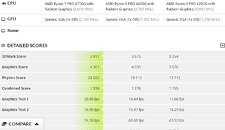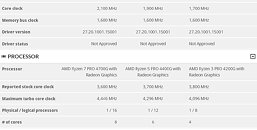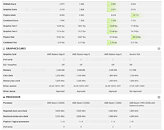Raevenlord
News Editor
- Joined
- Aug 12, 2016
- Messages
- 3,755 (1.20/day)
- Location
- Portugal
| System Name | The Ryzening |
|---|---|
| Processor | AMD Ryzen 9 5900X |
| Motherboard | MSI X570 MAG TOMAHAWK |
| Cooling | Lian Li Galahad 360mm AIO |
| Memory | 32 GB G.Skill Trident Z F4-3733 (4x 8 GB) |
| Video Card(s) | Gigabyte RTX 3070 Ti |
| Storage | Boot: Transcend MTE220S 2TB, Kintson A2000 1TB, Seagate Firewolf Pro 14 TB |
| Display(s) | Acer Nitro VG270UP (1440p 144 Hz IPS) |
| Case | Lian Li O11DX Dynamic White |
| Audio Device(s) | iFi Audio Zen DAC |
| Power Supply | Seasonic Focus+ 750 W |
| Mouse | Cooler Master Masterkeys Lite L |
| Keyboard | Cooler Master Masterkeys Lite L |
| Software | Windows 10 x64 |
Renowned leaker APISAK has digged up benchmarks for AMD's upcoming Ryzen 4700G, 4400G and 4200G Renoir APUs in 3D Mark. These are actually for the PRO versions of the APUs, but these tend to be directly comparable with AMD's non-PRO offerings, so we can look at them to get an idea of where AMD's 4000G series' performance lies. AMD's 4000G will be increasing core-counts almost across the board - the midrange 4400G now sports 6 cores and 12 threads, which is more than the previous generation Ryzen 5 3400G offered (4 cores / 8 threads), while the top-of-the-line 4700G doubles the 3400G's core-cpount to 8 physical and 16 logical threads.
This increase in CPU cores, of course, has implied a reduction in the area of the chip that's dedicated to the integrated Vega graphics GPU - compute units have been reduced from the 3400G's 11 down to 8 compute units on the Ryzen 7 4700G and 7 compute units on the 4400G - while the 4200G now makes do with just 6 Vega compute units. Clocks have been severely increased across the board to compensate the CU reduction, though - the aim is to achieve similar GPU performance using a smaller amount of semiconductor real-estate.



The 4700G's 8 Vega CUs clocked at 2.1 GHz, as reported by the benchmark suite, achieve 4,301 points in the graphics and 23,392 points in the CPU score, which are respectively 6.65% and 22.3% higher than the 4400G's 4,033 and 19,113 points (achieved with the same 8 Vega CUs clocked at a slower 1.9 GHz and with two fewer cores. The 4700G scores 20% and a whopping 70.6% higher than the 4200G's in the graphics and physics tests respectively - which makes sense, considering the slower-clocked 6 Vega CUs (1.7 GHz) and 4 core / 8 thread configuration of the former. AMD's 4000G series keeps the same 65 W TDp despite higher number of CPU cores and higher-clocked Vega cores, but the company will also have Ryzen 400=GE series which achieve a 35 W TDP, albeit at the cost of reduced CPU clocks (and likely GPU clocks as well).
_rogame, another well-known leaker, found two comparable system configurations running the Ryzen 4200G and 3200G, where the 4200G delivered 57% higher CPU performance, but 7% less GPU performance.

View at TechPowerUp Main Site
This increase in CPU cores, of course, has implied a reduction in the area of the chip that's dedicated to the integrated Vega graphics GPU - compute units have been reduced from the 3400G's 11 down to 8 compute units on the Ryzen 7 4700G and 7 compute units on the 4400G - while the 4200G now makes do with just 6 Vega compute units. Clocks have been severely increased across the board to compensate the CU reduction, though - the aim is to achieve similar GPU performance using a smaller amount of semiconductor real-estate.



The 4700G's 8 Vega CUs clocked at 2.1 GHz, as reported by the benchmark suite, achieve 4,301 points in the graphics and 23,392 points in the CPU score, which are respectively 6.65% and 22.3% higher than the 4400G's 4,033 and 19,113 points (achieved with the same 8 Vega CUs clocked at a slower 1.9 GHz and with two fewer cores. The 4700G scores 20% and a whopping 70.6% higher than the 4200G's in the graphics and physics tests respectively - which makes sense, considering the slower-clocked 6 Vega CUs (1.7 GHz) and 4 core / 8 thread configuration of the former. AMD's 4000G series keeps the same 65 W TDp despite higher number of CPU cores and higher-clocked Vega cores, but the company will also have Ryzen 400=GE series which achieve a 35 W TDP, albeit at the cost of reduced CPU clocks (and likely GPU clocks as well).
_rogame, another well-known leaker, found two comparable system configurations running the Ryzen 4200G and 3200G, where the 4200G delivered 57% higher CPU performance, but 7% less GPU performance.

View at TechPowerUp Main Site







